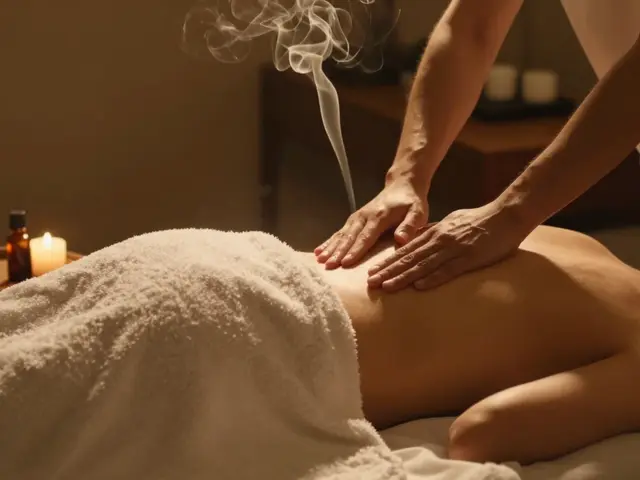Body massage isn’t just a luxury—it’s a power tool for shaking off stress, muscle aches, and even bad moods. With daily life piling on tension (hello, endless to-do lists), a good massage can hit reset fast.
You don’t need to be an expert to notice your shoulders drop after just fifteen minutes on the table. That sense of calm? Science backs it up: studies show massage lowers cortisol, your main stress hormone, and bumps up those chill-out chemicals like serotonin. It’s not just about muscles—your mind benefits, too.
Ever leave work with knots in your neck or a headache that's just not quitting? A quick session can help, whether you get a professional treatment or work out a cramp with a massage gun at home. Even a basic back rub can make a difference.
- Key Takeaways
- Quick Answer: Why Choose a Body Massage?
- What Is Body Massage and How Does It Work?
- The Benefits of Getting a Body Massage
- Massage Types: What Are Your Options?
- How to Book the Right Massage for You
Key Takeaways
Here’s the quick rundown before we dig deeper. If you’re eyeing a body massage, these points tell you what to expect and why it actually matters.
- Body massage isn’t just about pampering. It can reduce muscle tension, help with sore spots, and boost how you feel—both mentally and physically.
- Research found that people who get regular massage therapy see lower stress levels and even sleep better. The American Massage Therapy Association reports over 47 million Americans got a massage last year for health reasons, not just relaxation.
- There’s more than one way to get a body massage: Swedish, deep tissue, sports, and more. Each type targets something different, so you’re not stuck with a one-size-fits-all approach.
- You don’t always have to splurge on fancy spas. Local clinics, mobile therapists, and even self-massage tools can give you relief on your own schedule.
- Prices can range from $60 for a basic one-hour session to $150 or more at high-end places. Health insurance sometimes covers it, especially if your doctor says it’ll help a specific issue.
- Getting a massage is safe for most people, but always check with a pro if you have health issues. Talking with your therapist up front—about comfort, pressure, and problem areas—makes all the difference.
| Benefit | How Many Reported It (%) |
|---|---|
| Less stress | 81 |
| Pain relief | 62 |
| Better sleep | 58 |
| Improved mood | 55 |
Bottom line? A body massage can be practical, affordable, and way more than just a treat—think of it as part of your personal toolkit for feeling better every day.
Quick Answer: Why Choose a Body Massage?
Feeling drained, sore, or just wound up? That's exactly when a body massage shines. Seriously, it isn’t just about “pampering yourself”—real research points to massage as a proper way to tackle pain, manage stress, and just feel better overall.
Here’s what gets people hooked: on average, 88% of folks who get regular massage therapy say they notice more flexibility, fewer headaches, and a lighter mood. And it’s not just a placebo—your brain literally gets a chemical boost, flooding your system with those “feel good” hormones while slowing down the ones that keep you on edge.
| Reason | Percent of People Noticing Improvement |
|---|---|
| Less Muscle Tension | 79% |
| Less Stress/Anxiety | 68% |
| Better Sleep | 61% |
If you’re an athlete, work at a desk, or are just done chasing your kids around all day, a body massage helps loosen those stubborn knots, improves your blood flow, and gives you back that energy you lost somewhere between the carpool and the office.
“Massage matters—not just for muscle health but for mental health too. There’s real science now showing benefits for chronic pain, stress, and overall wellness.” — American Massage Therapy Association
So if you’re wondering, “Is this worth it?” the short answer is yes. A well-timed massage isn’t just nice—it’s actually good for your health. Win-win.
What Is Body Massage and How Does It Work?
A body massage is basically a hands-on way to help your muscles chill out. Someone (usually a pro) uses their hands, elbows, or special tools to press, rub, and move your skin and muscles. The main goal? Ease pain, relax you, and help your body recover from daily grind or workouts. It sounds simple, but there’s a lot happening under the surface.
During a session, your massage therapist targets certain muscle groups, depending on what you need. Feeling stiff from sitting at a desk? They'll focus on your neck and shoulders. Sore from the gym? Legs and back get more attention. The pressure can be light, medium, or deep—just let your therapist know how you feel.
Here's what actually goes down in your body:
- Muscles loosen up: Knots and tight spots get less cranky.
- Blood flow improves: When your muscles relax, blood moves easier, delivering more oxygen to tired spots.
- Stress drops: Massage lowers cortisol, which is the hormone that makes you feel wired or stressed out.
- Feel-good hormones rise: Serotonin and dopamine go up, which is why you often leave feeling almost giddy.
Ever heard of lymph drainage? That’s just a fancy way of saying massages can help your body get rid of waste and toxins faster. So besides just feeling good, you might notice less puffiness or muscle swelling.
If you want numbers, check this out. A review in the "International Journal of Preventive Medicine" (2014) found that people who got massages showed clear drops in anxiety and improvements in sleep. Not magic—it’s legit science.
This isn’t just about relaxing—regular massage therapy can actually help with chronic pain, headaches, and even recovery from injuries. That’s why you’ll see athletes, office workers, and even older adults laying on those massage tables.

The Benefits of Getting a Body Massage
The main reason folks book a body massage is pretty simple: they want to feel better fast. Sure, it's relaxing, but there’s more going on under the surface than you might think. When someone works out those knots, your whole system gets a boost.
Researchers at the Mayo Clinic say it straight:
"Massage isn't just a feel-good indulgence. It's a powerful tool to help you take charge of your health and well-being."
Let’s nail down the major benefits:
- Stress buster: Regular body massage lowers cortisol (the stress hormone), which can ease anxiety and just help you chill out. Even a single session can help your mood.
- Pain relief: Tight shoulders? Sore lower back? Massage helps by relaxing muscles, improving blood flow, and cutting down inflammation. That means less pain and a lot more comfort.
- Better sleep: When you’re relaxed and your muscles aren't tense, it’s way easier to fall asleep. Some people say their post-massage snooze is the best all week.
- Boosted immunity: Consistent massage has been linked to a stronger immune response. In other words, less sick days.
- Improved flexibility: Looser muscles mean better range of motion, so you move more easily—great if you’re a gym regular or just want to be limber chasing after the kids.
- Headache help: If you get tension headaches, working on your neck and shoulders can take the edge off or even keep headaches away.
Interested in numbers? There's proof:
| Benefit | Percentage of People Who Reported Improvement* |
|---|---|
| Less stress | 74% |
| Less pain | 69% |
| Better sleep | 60% |
*Source: American Massage Therapy Association survey, 2023.
Bottom line? Massage therapy brings real, everyday perks—less pain, better sleep, smoother moves, and plenty of relaxing vibes to make life smoother.
Massage Types: What Are Your Options?
When it comes to body massage, there’s way more than one approach. Different types focus on relaxation, pain relief, or even helping you recover from a tough workout. Not sure what to pick? Let’s break down the most common options you’ll see on a spa menu or gym board.
- Swedish Massage: Think of this as the classic “starter” massage. The therapist uses long, gentle strokes and a little kneading to help you relax. Perfect if you’re new to massage or just want that general stress relief.
- Deep Tissue Massage: Got stubborn knots or sore muscles from sitting all day? Deep tissue works on the deeper layers with slow, firm pressure. It can be uncomfortable at times, but you’ll really notice the release after.
- Sports Massage: Active folks swear by this one. Therapists target specific muscle groups used in your sport or activity. It’s great for injury prevention, flexibility, and faster recovery.
- Thai Massage: This one’s a bit different—no oils, and you stay mostly clothed. Therapists stretch and move your body through positions kind of like assisted yoga. You’ll walk out looser and more limber.
- Hot Stone Massage: If you love warmth, try this. Heated stones are used to help muscles relax faster and boost circulation. It’s super calming, especially in winter.
- Chair Massage: Short on time? You’ve seen these at airports or malls. It’s quick, clothes-on, and focuses on your back, neck, and shoulders. A solid pick if you need relief but can’t commit to a full hour.
Still not sure what you need? Therapists can usually combine styles based on what you tell them—just ask. If you’re dealing with something like chronic pain or a medical condition, mention it upfront so they can adjust the session.
| Massage Type | Best For | Typical Duration |
|---|---|---|
| Swedish | Stress relief, first-timers | 60-90 min |
| Deep Tissue | Chronic tension, athletes | 60-90 min |
| Sports | Active recovery | 30-60 min |
| Thai | Flexibility, stretching | 60-120 min |
| Hot Stone | Soothing warmth, relaxation | 60-90 min |
| Chair Massage | Quick relief, office workers | 10-30 min |
Quick tip: Trying a few different types over time helps you figure out what really lights you up. Everyone’s body is a little different, so don’t be afraid to experiment until you land on the best massage therapy for your routine.
How to Book the Right Massage for You
Finding the perfect body massage isn’t rocket science, but it helps to have a clear game plan—especially if you want your cash and time to feel well spent. Here’s how you can make the process easy and stress-free.
- Figure out what you need: Do you want deep relief for sore muscles, or do you just need to chill out after a busy week? Different types of massage work best for different needs—Swedish for relaxation, deep tissue for aches, or maybe a Thai massage if you want a stretch, too.
- Do your homework: Check out local clinics, spas, or even registered mobile therapists in your area. Google Maps and business review sites like Yelp or Trustpilot make recommendations simple to compare. Look for consistent positive reviews—steady five-star ratings are a good sign, but actually read what people say.
- Check the qualifications: Make sure the therapist is certified and licensed. In most states, massage therapists need a license, and you can usually look this up through local health department websites.
- See what fits your schedule and price: Most places have booking calendars online. Some even list last-minute deals if you’re flexible. Pricing varies—expect anywhere from $70 to $120 per hour for a legit massage therapy session in most American cities. Some spas offer intro specials for first-timers or lower rates for shorter sessions.
- Double check hygiene and safety rules: High standards aren’t just for luxury places. Check for details like changing sheets after every client and therapists washing their hands before each session. It’s basic, but it matters for your safety.
- Ask about extra amenities: Some places throw in perks—think: free hot stones, aromatherapy, or shower access. Sometimes these are included in the price, sometimes they’re extra, so always check ahead if this stuff matters to you.
If you’re a numbers person, here’s how prices typically break down across different types in the U.S.:
| Massage Type | Typical Price (1 hour) |
|---|---|
| Swedish | $70-$110 |
| Deep Tissue | $80-$120 |
| Thai | $90-$130 |
One last tip: Always ask about cancellation policies. Some places charge fees for last-minute changes, so better to know that before you book. Once you’ve settled on your therapist and time, booking online is usually quicker than over the phone. Most sites send you a confirmation and easy rescheduling links if you need to switch things up.












